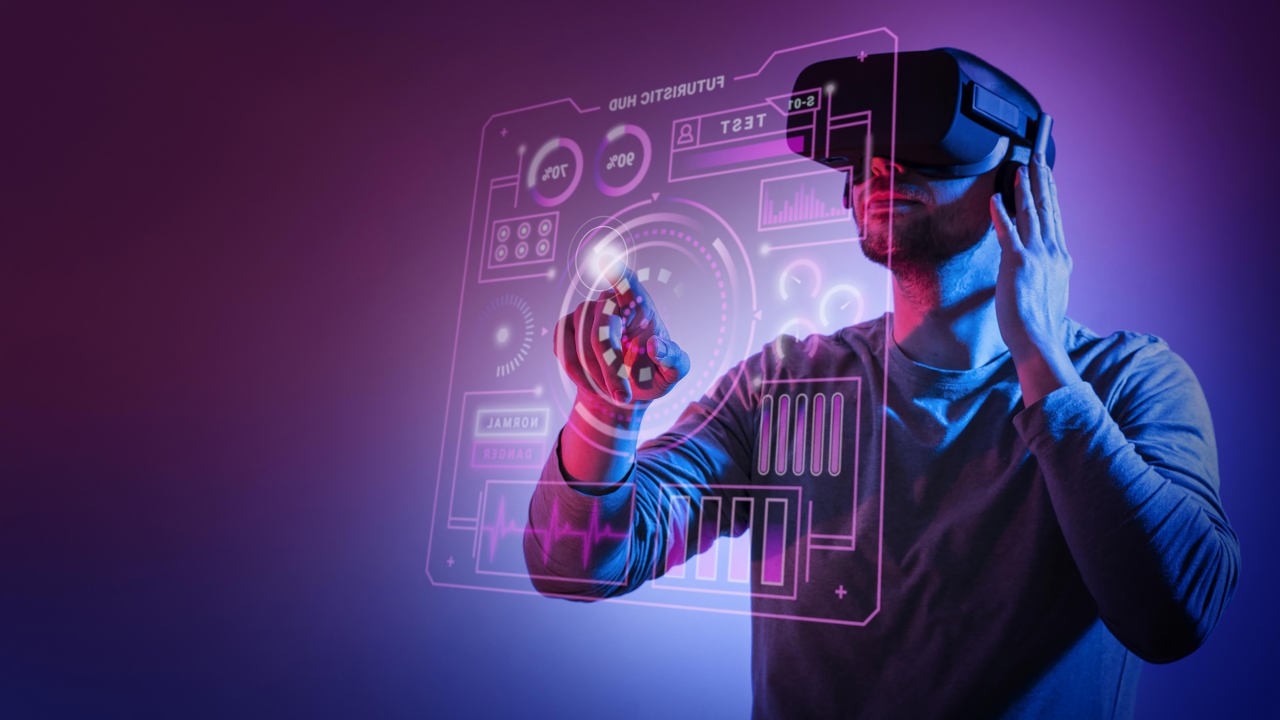Virtual reality (VR), along with VR development, is part of a global market that was forecast “to reach 30.7 billion U.S. dollars” last year. Yet, Statista’s data also signals an expected rise “to close to 300 billion U.S. dollars by 2024.” From making ads more interesting to improved prototyping of complex products, VR technology can go as far as providing remote inspection and maintenance in manufacturing.
Needless to say, this avant-garde tech suits a broad base of millennial clients. This large group, as we’ve addressed in the past, is statistically ready for more immersive and high-quality digital financial products that give a wowing customer experience.
Thinking about these facts, we’re going over the state of VR development today across the fintech and banking industries.
The advancement of technology
For The Fintech Blueprint, “we have actually come to the point that the human mind is not able to distinguish the difference between modeled visual information and actual visual information.” In their recent analysis on Apple’s augmented reality leak, and what Fintech should do for the coming Multiverse, they make it very clear that “technologies will continue to merge to the point of us being completely unable to tell reality apart from fiction.” Their examples on rendered worlds created at the interstice between interactive games and scripted movies are astonishing.
Similarly, the intervening space between virtual reality (VR) and fintech is resulting in numerous innovative solutions in diverse scenarios.
Why Virtual Reality was dependent on other technologies
Let’s clarify why the latest years signify a boosting movement for fintech when combined with virtual reality.
The history around screen quality, including mobile phone developments, and headsets is of utmost relevance in this regard. Essentially because these needed considerable improvement before we could get to the kind of display and visual quality with which VR is working right now.
The quality of screens and pixel density is a determining factor. And gaming has had a lot to do with continued improvements in these areas. As GamesIndustry.biz put it, “Key development concepts in VR revolve around locomotion, comfort, interaction and optimisation. But these are constantly evolving.” Though referring to games, the same applies for development of VR in other fields.
As these experts expand, “There are things that you simply can’t do in VR — or rather shouldn’t try to do — such as any type of combo-based combat mechanic or very cinematic experiences.” So, let’s see how we can convert efforts into great and actual use of VR in fintech services.
How can companies integrate VR into client experience offers?
This must be the most long-standing question for VR in many ways. It’s probably why Matthias McCoy-Thompson, then COO and Co-founder of Agora VR, already presented ways in which companies can do that. Over a series of short videos, he listed at least five aspects that answered that query years back. These are: to scale, for flexibility, 3D Interaction, as part of telecommunication, and for immersion. The point for this COO is to think about virtual reality as a tool that’s coming in to improve a business.
How do we translate VR development into actionable items?
Think of VR simulation & training, for example. VR platforms offer a consistent, interactive experience regardless of physical environment. They also allow immersive content to be available on-demand, rather than competing with schedule and location restrictions. This is also how savings are possible. With them, organizations can cut back on travel, onsite training, and equipment costs, to name a few.
There are positive implications to these kinds of platforms in terms of global recruitment for world-class talent, as well.
VR development and big data
Let’s zoom closer at fintech and tie that in with big data issues, for example. ThinkML, a community passionate about Machine Learning, Data Science, and Business Intelligence values that, “With the rapid growth in Fintech, it is becoming a complicated process to deal with big data and availability of information in real time”. VR-related measures can help some of those blockages.
For them, “VR, along with AR, has solutions for all problems.” As they emphasize, the technology can help make decisions real-time by giving out “all relevant information as augmented data visualization” while users are still in the virtual plane. In a nutshell, AR can help as “all relevant information can be provided to customer [sic] efficiently during the VR experience by rendering it in real-time using visualizations”. Exceeding at fulfilling needs in real-time is a key word here.
Let’s see what exists in terms of VR in banking.

Implementations of VR in banking
ThinkML, the community mentioned above, also contemplates many savings out of VR implementation in the banking sector. They consider how “an application of VR in the Banking industry will eliminate the need for physical banks.” By now, we know Augmented Reality to be assisting customers “find the nearest banks and ATMs,” which is something Fast Invest also brings to the discussion.
Yet, the promise at the time of that publishing by FastInvest was also on “mortgage calculators and 3D interiors” that come in these AR settings. For ThinkML, VR also “enhanced the comfort for bankers, employers, and users to attend virtual meetings while staying at home”. Beyond this capability, ThinkML also considers how “VR gives a vivid learning experience to teach youngsters about cash. Showing kids how to spare, put away and oversee cash and how to settle on savvy budgetary choices much more viable with augmented reality.”
VR can bring improvement in payment processing
Going back to The Fintech Blueprint, “the killer use case for AR/VR finance will be payments processors”. Their bet is on blockchain-anchored payment processors, to be more specific. Moreover, their “bold move for a financial company would be to leapfrog from ‘technology’ company to ‘media’ company today.” The comment is geared towards a bank “underwrit[ing] the creation of all these worlds on a common visual engine, and then us[ing] smart contracts and APIs to integrate its products across available financial activities.”
More poignantly, the company poses the question as to “Why […] gaming companies have to design in-game economies, rather than picking them up off the shelf from a financial modeler.” For them, big banks can create video game studios that already integrate banking accounts. One vital aspect would be for users to easily transact between main currencies and BitCoin, for example. Tencent, a Chinese multinational technology and entertainment conglomerate, is said to already be ahead in that aspect.
Visa and MasterCard already use VR technology
From ThinkML, we also know that Visa has already “introduced an augmented reality payment mobile app that uses VR technology to open 3D map on the screen and provide users an exciting way of selecting the outlet and choosing the item of interest and then payment processing without leaving VR world.” For a peek at that implementation, check out Visa’s video on these services.
On the other hand, this same source also presents advancement on MasterCard’s front. That company “joined hands with Wearability to provide virtual buying experience to their customers”. Consumers can go on virtually created environments to make their purchases.
A German bank is leading globally with VR
There’s also Commerzbank to think about; Germany’s second largest bank. According to ThinkML, they’re “the first commercial bank to open a virtual branch called LiveBank.” The source highlights customer survey reports that express LiveBank’s main benefit as having “restored the personal, face-to-face interaction to some extent which got lost with the transition to internet and mobile banking.” VR banking platforms are a recurrent thought that seems to gain more and more traction in the “real” world.
Moving over to Poland, an IT company named Comarch is already using VR as part of their wealth management software. The assertion by ThinkML is that “it allows users to understand algorithms and other trading tools better.”
Virtual workstations can help with trading
As per FastInvest, however, we also know that “Some companies are making trading a virtual experience by creating virtual reality workstations for trading”. As part of their examples, they cite Citi using “Microsoft HoloLens to give traders Holographic Workstations. This type of workstation offers 2D and 3D elements that add to the bank’s existing processes.”
The same source throws biometric security to the mix. For them, that could be part of “an AR system that could then connect with a VR world”. The advantage would be that “These could be used to access VR bank services, make ATM transactions, or make payments”.
VR development is only bound to improve in fintech and banking
VR development can certainly bring tons of implementations to fintech and banking.
To follow up on industry connections and useful resources, there are different local, national, and international liaisons to consider. Look out for events and different initiatives making advancements in VR technology.
In-person conferences are quickly coming back, too. There are scheduled Virtual Reality conferences touring all over the world in the next couple of years.
Otherwise, partner with a reliable fintech and banking provider that can implement the latest in VR technology. As proven, there’s tons happening on the topic worldwide, and much more yet to come!







